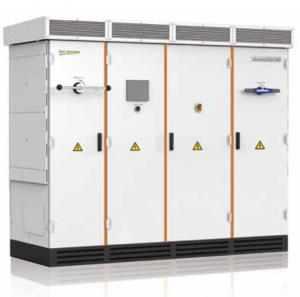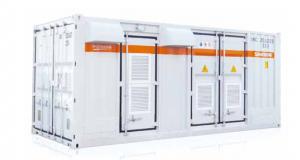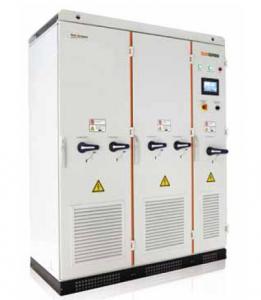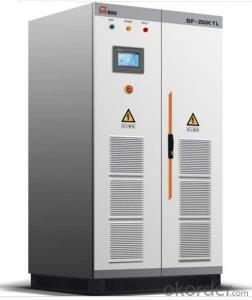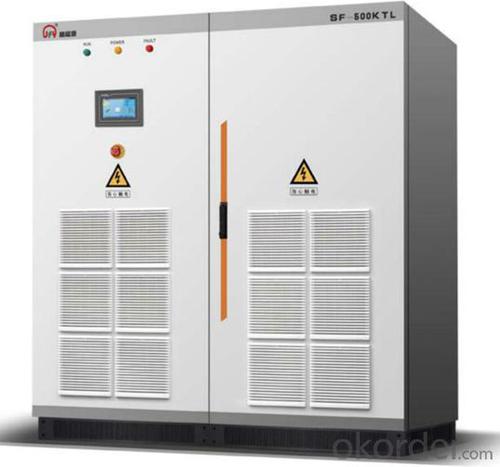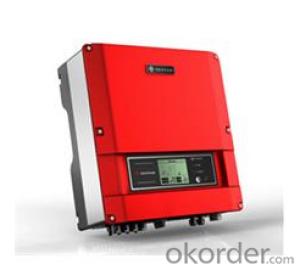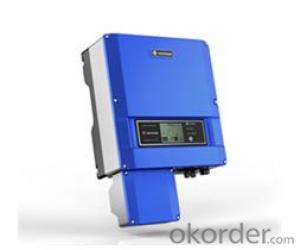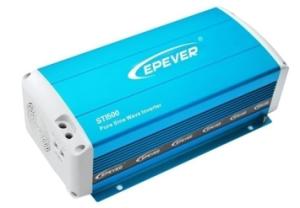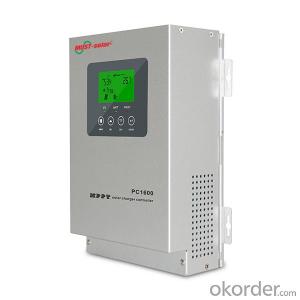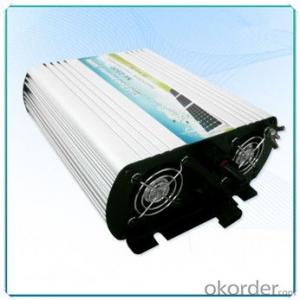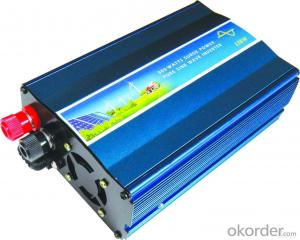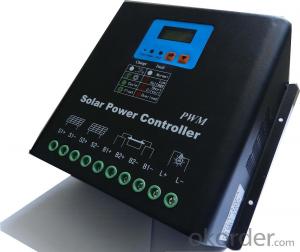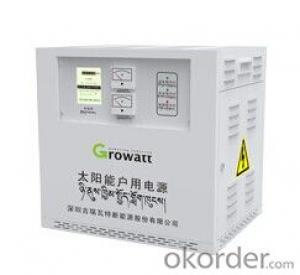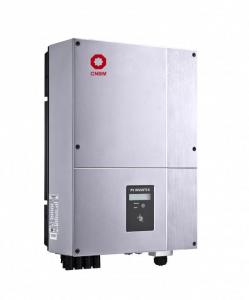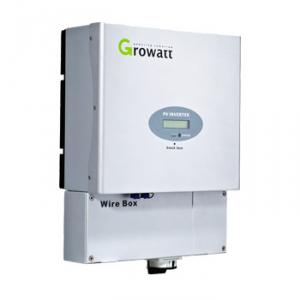500KW Solar Inverter For Solar Power Plant or Solar Power System without Transformer
- Loading Port:
- China main port
- Payment Terms:
- TT or LC
- Min Order Qty:
- 10 unit
- Supply Capability:
- 1000 unit/month
OKorder Service Pledge
OKorder Financial Service
You Might Also Like
1. Structure of 500KW Solar Inverter for Solar Power Plant or Solar Power System without Transformer Description
A solar inverter, or PV inverter, or Solar converter, converts the variable direct current (DC) output of a photovoltaic (PV) solar panel into a
utility frequency alternating current (AC) that can be fed into a commercial electrical grid or used by a local, off-grid electrical network. It is
a critical BOS–component in a photovoltaic system, allowing the use of ordinary AC-powered equipment. Solar inverters have special
functions adapted for use with photovoltaic arrays, including maximum power point tracking and anti-islanding protection.
2. Main Features of 500KW Solar Inverter for Solar Power Plant or Solar Power System without Transformer
• With the advanced system intelligence, highly speed MPPT technology, industrial-grade engineeringand compete fault
protections,Sunforest series central commercial inerters maximize system uptime and power production, even in harshest
environments
• DSP-controlled IGBT circuitry to achieve high efficiency, reliability and low installing cost.
• Sunforest KT series grid-tied inverters are integrated with an isolatin transformer
• Multiple work mode, SVG(Static Var Generator) mode, Anti-Reverse power control mode
Utility-read features
• Open communication protocol, good compatible with any third-party monitoring system and easily integrated into SCADA
systems
• Remote control of real and reactive power
• LVRT(Low voltage ride through)
• Power factor control
• Simplified grid interconnection
Optimal MPPT technology
• Rapid and accurate control boost PV plant KWH yield
• Provides a wide range of operation voltage
3. 500KW Solar Inverter for Solar Power Plant or Solar Power System without Transformer Images
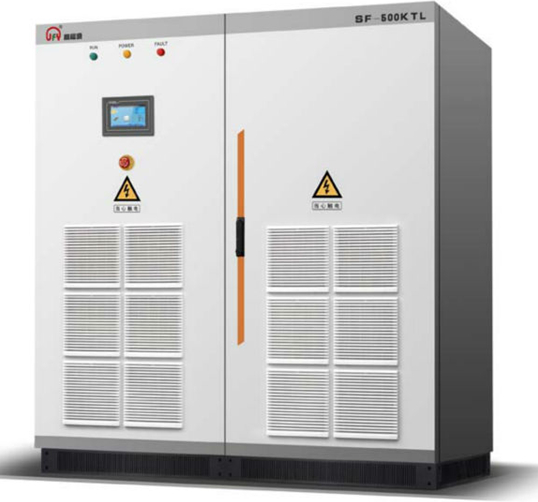
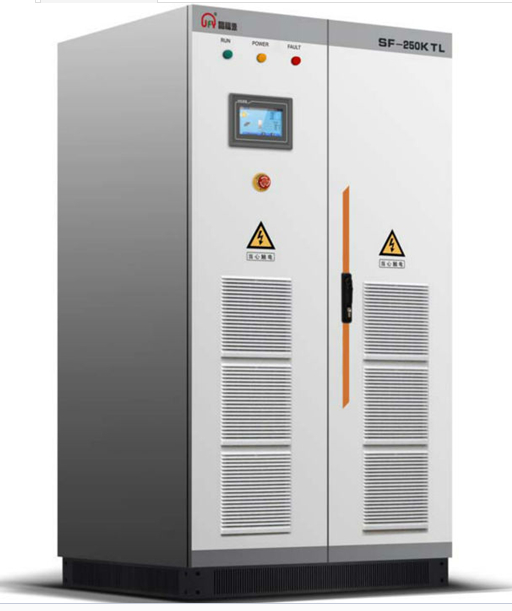
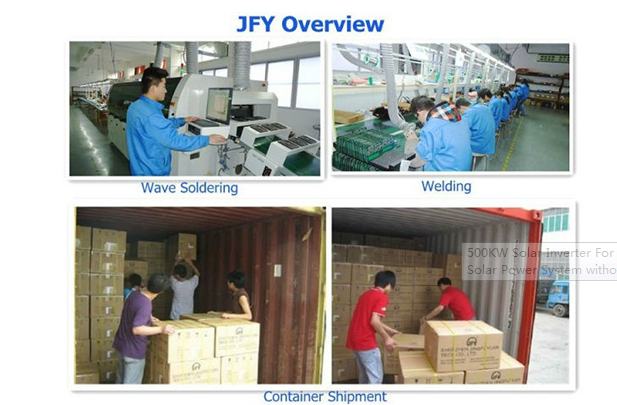
4. 500KW Solar Inverter for Solar Power Plant or Solar Power System without Transformer Specification
Max. DC Input Power | 285KW | 570KW | 715KW |
Max DC Voltage | 1000Vdc | ||
MPPT Operating Range | 450~820Vdc | ||
Number of Parallel Inputs | 5 | 12 | |
Number of MPP Trackers | 1 | ||
Max. Input Current | 600A | 1200A | 1400A |
Nominal Output Power | 250KW | 500KW | 630KW |
Max. Output Power | 275KW | 550KW | 693KW |
Nominal Output Current | 535A | 1070A | 1155A |
Max. Output Current | 589A | 1177A | 1270A |
Nominal AC Output Voltage | 270Vac | 270Vac | 315Vac |
AC Output Voltage Range | 243~297Vac | 283~347Vac | |
AC Grid Frequency Range | 50Hz | ||
Power Factor (cosφ) | 0.9(leading)~0.9(lagging) | ||
THDI | <3% | ||
Max.efficiency | 98.40% | 98.50% | 98.60% |
Euro.efficiency | 98.00% | 98.00% | 98.20% |
MPPT. efficiency | 99.90% | 99.90% | 99.90% |
Operating Temperature | -25°C~+60°C(derated power above50°C) | ||
Altitude | 6000m(derated power above 3000m) | ||
Noise (typical) | <65dB(A) | ||
Operating Consumption | <100W | ||
Electrical Isolation | Transformerless | ||
Cooling Concept | Fan Cooling | ||
Protect Level | IP20 | ||
Communication | RS485 | ||
Dimension (W×D×H)(mm) | 1000*900*1850 | 1700*900*1850 | 1700*900*1850 |
Weight (Kg) | 890 | 1427 | 1677 |
5. FAQ of 500KW Solar Inverter for Solar Power Plant or Solar Power System without Transformer
Q1:Can we visit your factory?
A1:Sure,welcome at any time,seeing is believing.
Q2:Which payment terms can you accept?
A2:T/T,L/C,Moneygram,Paypal are available for us.
- Q: Can a solar inverter be used with a string inverter system?
- No, a solar inverter cannot be used with a string inverter system. Solar inverters and string inverters are two different types of inverters that serve different functions in a solar power system. A solar inverter is designed to convert the DC power generated by solar panels into AC power for use in homes or businesses. On the other hand, a string inverter is used to convert the DC power generated by multiple solar panels connected in series, known as a string, into AC power. Therefore, these two types of inverters are not compatible with each other.
- Q: Can a solar inverter be used with different brands of solar panels?
- Yes, a solar inverter can be used with different brands of solar panels as long as they have compatible specifications and electrical characteristics. However, it is recommended to consult the inverter manufacturer's guidelines or seek professional advice to ensure compatibility and optimal performance.
- Q: How does a solar inverter convert DC to AC power?
- A solar inverter converts direct current (DC) power generated by solar panels into alternating current (AC) power that can be used in households and businesses. It does this through a two-step process. Firstly, the DC power from the solar panels is converted into a high-frequency AC power using power electronic switches, usually in the form of transistors. This high-frequency AC power is then transformed into a stable AC power with the desired voltage and frequency using transformers and filters. Overall, the solar inverter ensures that the DC power generated by the solar panels is converted into a usable AC power that can be fed into the electrical grid or consumed directly.
- Q: How does a solar inverter handle grid faults and disturbances?
- A solar inverter is designed to handle grid faults and disturbances by continuously monitoring the grid conditions. In the event of a fault or disturbance, such as a voltage or frequency fluctuation, the solar inverter will quickly disconnect from the grid to ensure the safety of the system. Once the fault is resolved and the grid conditions stabilize, the solar inverter will reconnect to the grid and resume normal operation, ensuring a reliable and stable power supply.
- Q: Can a solar inverter be connected to a generator?
- Yes, a solar inverter can be connected to a generator. This can be useful in situations where solar power is not sufficient or unavailable, allowing the generator to supplement the power supply.
- Q: What is the role of a solar inverter in preventing islanding?
- The role of a solar inverter in preventing islanding is to continuously monitor the electrical grid and quickly disconnect from it if it detects any abnormalities or disruptions. This prevents the solar inverter from operating in an isolated or "islanded" mode, which could pose safety risks to utility workers and damage electrical equipment. By promptly disconnecting from the grid during such events, the solar inverter helps maintain the stability and integrity of the overall electrical system.
- Q: Are all solar inverters compatible with all solar panels?
- No, not all solar inverters are compatible with all solar panels. The compatibility between inverters and panels depends on factors such as voltage, power output, and technology. It is important to ensure that the inverter and solar panels are compatible to optimize the performance and efficiency of the solar energy system.
- Q: Is the PV inverter a current source or a voltage source?
- Inverter is a kind of semiconductor device composed of power adjustment device, mainly used for DC power into AC power.
- Q: What is the role of a solar inverter in fault ride-through capability?
- The role of a solar inverter in fault ride-through capability is to ensure that the solar power system remains operational and stable during grid faults or disturbances. The inverter is responsible for detecting fault conditions and adjusting its output to mitigate the impact of the fault on the system. By providing fault ride-through capability, the solar inverter helps maintain grid stability and ensures continuous power supply from the solar panels even in the presence of faults.
- Q: Can a solar inverter be used with concentrated photovoltaic systems?
- Yes, a solar inverter can be used with concentrated photovoltaic (CPV) systems. However, the inverter used for CPV systems may differ from the ones used for traditional photovoltaic systems. CPV systems use lenses or mirrors to concentrate sunlight onto highly efficient solar cells, which generate DC power. This DC power is converted into AC power by the inverter, enabling it to be used for various applications or fed into the grid. Therefore, a specialized inverter designed to handle the unique characteristics and high levels of DC power output of CPV systems is required.
Send your message to us
500KW Solar Inverter For Solar Power Plant or Solar Power System without Transformer
- Loading Port:
- China main port
- Payment Terms:
- TT or LC
- Min Order Qty:
- 10 unit
- Supply Capability:
- 1000 unit/month
OKorder Service Pledge
OKorder Financial Service
Similar products
Hot products
Hot Searches
Related keywords

